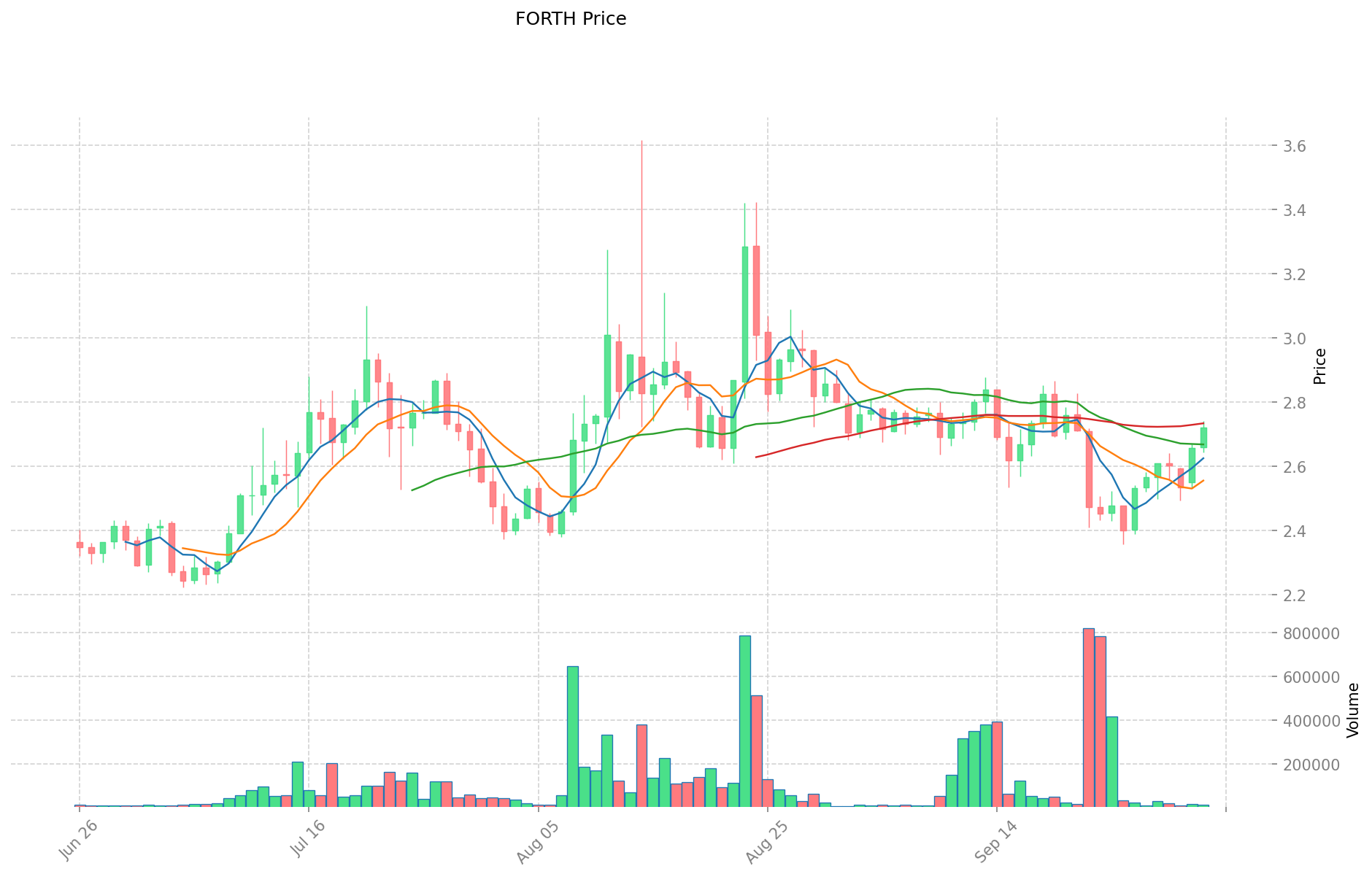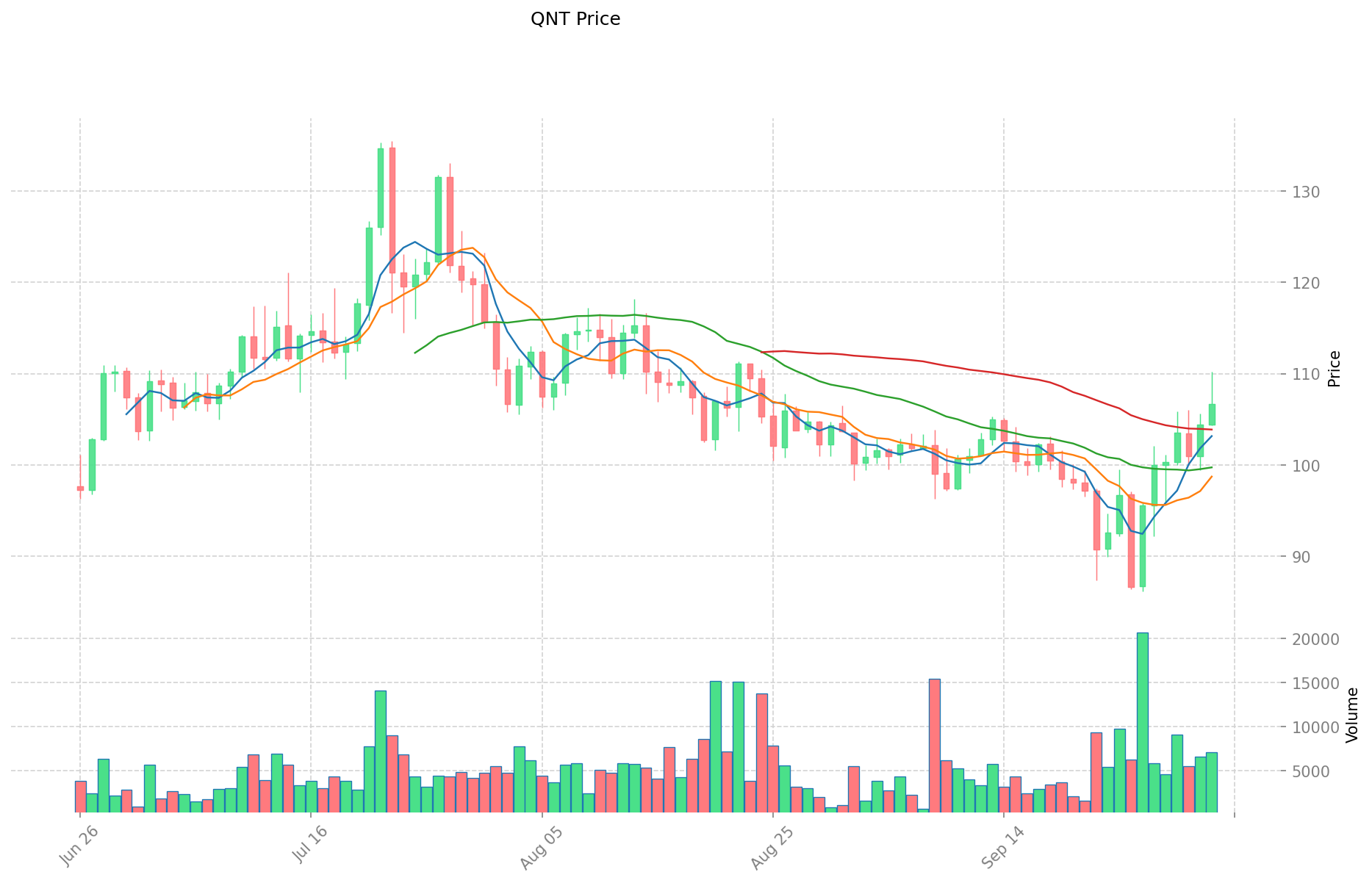FORTH vs QNT: Comparing Two Distinct Approaches to Programmable Blockchain Technology
Introduction: FORTH vs QNT Investment Comparison
In the cryptocurrency market, the comparison between FORTH and QNT has been an unavoidable topic for investors. The two not only show significant differences in market cap ranking, application scenarios, and price performance, but also represent different positioning in the crypto asset space.
Ampleforth (FORTH): Since its launch in 2021, it has gained market recognition for its innovative approach to elastic supply and DeFi applications.
Quant (QNT): Introduced in 2018, it has been hailed as a solution for blockchain interoperability, positioning itself as a leader in enterprise blockchain adoption.
This article will provide a comprehensive analysis of the investment value comparison between FORTH and QNT, focusing on historical price trends, supply mechanisms, institutional adoption, technological ecosystems, and future predictions, attempting to answer the question investors care about most:
"Which is the better buy right now?"
I. Price History Comparison and Current Market Status
FORTH (Coin A) and QNT (Coin B) Historical Price Trends
- 2021: FORTH launched in April, with an initial price of $54.44.
- 2021: QNT reached its all-time high of $427.42 in September due to increased adoption.
- Comparative analysis: During the 2021-2022 market cycle, FORTH dropped from its all-time high of $180.47 to a low of $1.89, while QNT showed more resilience, maintaining a higher price level.
Current Market Situation (2025-10-03)
- FORTH current price: $2.696
- QNT current price: $105.54
- 24-hour trading volume: $49,284.99 (FORTH) vs $346,541.14 (QNT)
- Market Sentiment Index (Fear & Greed Index): 64 (Greed)
Click to view real-time prices:
- Check FORTH current price Market Price
- Check QNT current price Market Price


II. Core Factors Affecting the Investment Value of FORTH vs QNT
Supply Mechanisms Comparison (Tokenomics)
- FORTH: Based on smart contracts, enabling lending and trading on decentralized exchanges
- QNT: Provides real-world data for trading applications
- 📌 Historical pattern: Supply mechanisms drive price cycles based on market trends and liquidity.
Institutional Adoption and Market Applications
- Institutional holdings: Market trends suggest varying levels of institutional interest in both tokens
- Enterprise adoption: Both tokens have potential applications in DeFi ecosystems
- Regulatory attitudes: Investment values may fluctuate based on regulatory developments
Technical Development and Ecosystem Building
- FORTH technical focus: DeFi protocol development enabling decentralized lending and trading
- QNT technical development: Real-world data integration for trading applications
- Ecosystem comparison: FORTH appears more focused on DeFi applications while QNT serves data needs
Macroeconomic Factors and Market Cycles
- Performance in inflationary environments: Both tokens subject to market volatility
- Macroeconomic monetary policy: Investment values may rise or fall depending on broader market conditions
- Geopolitical factors: Cross-border transaction demand may influence adoption rates
III. 2025-2030 Price Prediction: FORTH vs QNT
Short-term Prediction (2025)
- FORTH: Conservative $2.04 - $2.69 | Optimistic $2.69 - $3.90
- QNT: Conservative $77.10 - $105.63 | Optimistic $105.63 - $151.05
Mid-term Prediction (2027)
- FORTH may enter a growth phase, with expected prices of $2.86 - $5.03
- QNT may enter a consolidation phase, with expected prices of $120.50 - $193.62
- Key drivers: Institutional capital inflow, ETF, ecosystem development
Long-term Prediction (2030)
- FORTH: Base scenario $4.39 - $6.28 | Optimistic scenario $6.28 - $6.47
- QNT: Base scenario $178.98 - $215.63 | Optimistic scenario $215.63 - $314.83
Disclaimer: The information provided is for informational purposes only and should not be considered as financial advice. Cryptocurrency markets are highly volatile and unpredictable. Always conduct your own research before making any investment decisions.
FORTH:
| 年份 | 预测最高价 | 预测平均价格 | 预测最低价 | 涨跌幅 |
|---|---|---|---|---|
| 2025 | 3.9092 | 2.696 | 2.04896 | 0 |
| 2026 | 4.755744 | 3.3026 | 2.609054 | 22 |
| 2027 | 5.036465 | 4.029172 | 2.86071212 | 49 |
| 2028 | 6.119304975 | 4.5328185 | 3.44494206 | 68 |
| 2029 | 7.243443963 | 5.3260617375 | 3.674982598875 | 97 |
| 2030 | 6.4732954357575 | 6.28475285025 | 4.399326995175 | 133 |
QNT:
| 年份 | 预测最高价 | 预测平均价格 | 预测最低价 | 涨跌幅 |
|---|---|---|---|---|
| 2025 | 151.0509 | 105.63 | 77.1099 | 0 |
| 2026 | 142.4578995 | 128.34045 | 110.372787 | 21 |
| 2027 | 193.6208198925 | 135.39917475 | 120.5052655275 | 28 |
| 2028 | 207.282596624775 | 164.50999732125 | 95.415798446325 | 55 |
| 2029 | 245.3831120043765 | 185.8962969730125 | 133.845333820569 | 76 |
| 2030 | 314.83396855349397 | 215.6397044886945 | 178.980954725616435 | 104 |
IV. Investment Strategy Comparison: FORTH vs QNT
Long-term vs Short-term Investment Strategies
- FORTH: Suitable for investors focused on DeFi applications and ecosystem potential
- QNT: Suitable for investors seeking blockchain interoperability solutions and enterprise adoption
Risk Management and Asset Allocation
- Conservative investors: FORTH: 30% vs QNT: 70%
- Aggressive investors: FORTH: 60% vs QNT: 40%
- Hedging tools: Stablecoin allocation, options, cross-currency portfolio
V. Potential Risk Comparison
Market Risk
- FORTH: High volatility due to elastic supply mechanism
- QNT: Susceptible to fluctuations in enterprise blockchain adoption rates
Technical Risk
- FORTH: Scalability, network stability
- QNT: Interoperability challenges, security vulnerabilities
Regulatory Risk
- Global regulatory policies may have differing impacts on both tokens
VI. Conclusion: Which Is the Better Buy?
📌 Investment Value Summary:
- FORTH advantages: Innovative elastic supply mechanism, DeFi applications
- QNT advantages: Enterprise blockchain adoption, interoperability solutions
✅ Investment Advice:
- New investors: Consider a balanced approach with a slight bias towards QNT
- Experienced investors: Explore opportunities in both tokens based on risk tolerance
- Institutional investors: Evaluate QNT for its enterprise blockchain potential
⚠️ Risk Warning: Cryptocurrency markets are highly volatile. This article does not constitute investment advice. None
VII. FAQ
Q1: What are the key differences between FORTH and QNT? A: FORTH is focused on DeFi applications with an elastic supply mechanism, while QNT targets blockchain interoperability and enterprise adoption.
Q2: Which token has shown better price stability historically? A: QNT has demonstrated more price resilience, maintaining a higher price level during market fluctuations compared to FORTH.
Q3: How do the supply mechanisms of FORTH and QNT differ? A: FORTH uses a smart contract-based elastic supply mechanism, while QNT provides real-world data for trading applications without an elastic supply.
Q4: What are the predicted price ranges for FORTH and QNT in 2030? A: For FORTH, the base scenario is $4.39 - $6.28, with an optimistic scenario of $6.28 - $6.47. For QNT, the base scenario is $178.98 - $215.63, with an optimistic scenario of $215.63 - $314.83.
Q5: How should investors allocate their portfolio between FORTH and QNT? A: Conservative investors might consider 30% FORTH and 70% QNT, while aggressive investors might opt for 60% FORTH and 40% QNT.
Q6: What are the main risks associated with investing in FORTH and QNT? A: FORTH faces high volatility due to its elastic supply mechanism and potential scalability issues. QNT is susceptible to fluctuations in enterprise blockchain adoption rates and interoperability challenges.
Q7: Which token might be more suitable for institutional investors? A: QNT might be more appealing to institutional investors due to its focus on enterprise blockchain solutions and potential for wider adoption in the business sector.
Share
Content